Everything is Possible – Unfortunately
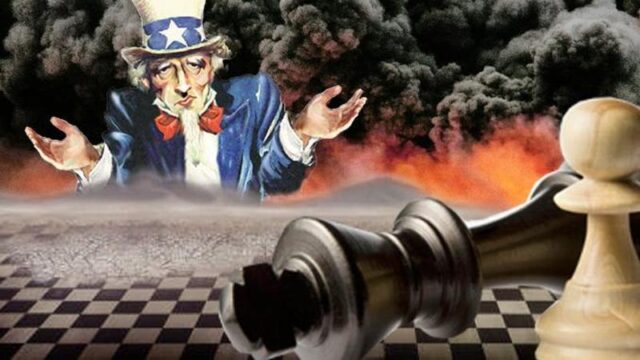
The situation in this world is becoming increasingly muddled and unpredictable. Trump has misjudged the Chinese, Putin is not backing down and Iran is too big a chunk for the Americans. In addition, there is historic instability in the financial markets.
Introduction
We sent greetings at the end of 2024 with the card below. “Anything is possible” – a handshake in the background – an optimistic message for the new year. A few months later, this attitude is already crying out for a change – unfortunately.
The world has now reached a level of instability that has the potential to ignite a firestorm in many countries and at several various levels. Some of the smouldering fires are flaring up beneath the surface – will they become firestorms?
Without claiming to be exhaustive, in this article we briefly describe what moves us – and should also move the rest of the world.
Smoldering fire 1 – Financial markets
Instability for years – Fed Put
We have long warned that instability in the financial markets, or rather their collapse, represents the greatest geopolitical risk and is regularly ignored by almost all geopolitical commentators.
The financial markets were already hanging by a thread long before President Trump’s second term in office. The mountain of debt is insane and valuations on the stock markets are maniacal. Since 1987, investors (or rather speculators) have relied on the central banks to come to their rescue in the event of a financial market collapse. This was the case in 1987 (“Black Monday” and the subsequent Greenspan Put), 1998 (systemic shock caused by the Russian sovereign default + hedge fund long-term capital management crisis), 2001 (dotcom crash), 2008 (financial crisis – Ben Bernanke and his quantitative easing (QE)) and 2020 (corona crash: Jerome Powell and his renewed quantitative easing (QE)). Investors are talking about the so-called Fed put (when things go wrong, the Fed simply “prints” money) and believe they have a common-law right to a bailout. As the US Fed is owned by the banks and most Western central banks are too, there is no need to ponder for long whose interests these ladies and gentlemen represent in their ivory towers; certainly not the interests of the citizens. Rescuing the financial markets for the benefit of speculators and banks is at the expense of the currency, as it becomes weaker with every such action.
These “rescues” are not acts of high intellectual virtue: The central banks simply “print” money (i.e. they create it electronically by making corresponding entries in the banks’ accounts) and thus save the banks and investors at the expense of the currency. For this reason, among others, the US dollar has lost 98.5% of its value against gold since 1971 and this trend has been accelerating since the beginning of this year.
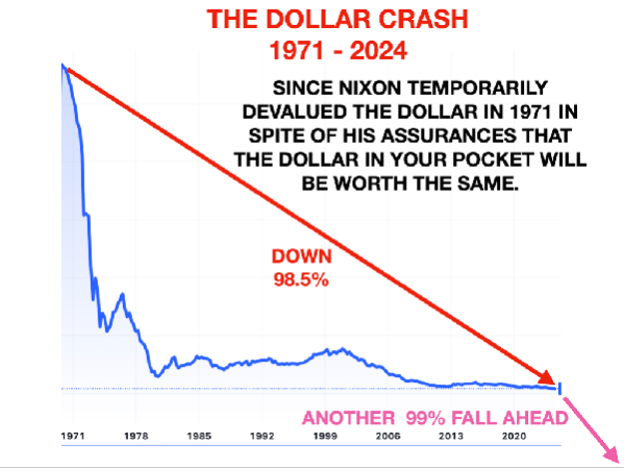
Source: vongreyerz.gold
However, the major danger does not come from the equity markets, but from the bond markets (government bonds). The global bond market is around three times the size of the global equity market.
Since the escalation of the tariff dispute, the rule that investors flee to bonds when share prices fall no longer seems to apply.


What is new is that the bond markets are also suffering as the equity markets fall.
The US dollar is also losing value. As an extreme example, I show here the exchange rate of the US dollar against the Swiss franc.
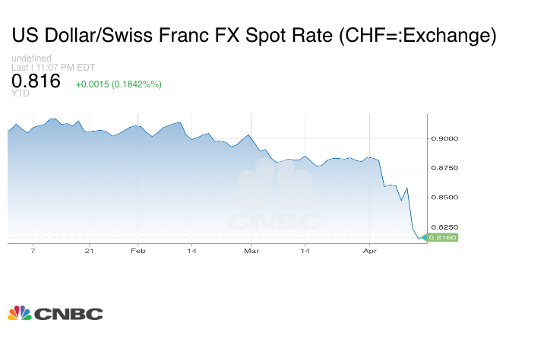
We are not predicting when a collapse will occur, but it will happen. A crash always comes when investor confidence is destroyed, which is an emotional act. If you look for rational reasons, a collapse is overdue. Shock news such as the Trump tariff bonanza is perfectly capable of turning the mood around within a very short space of time. One should not smoke in a powder keg.
The main problem for investors will be finding an escape route when things go pear-shaped. Historically, investors have taken refuge in US government bonds; however, this route no longer seems very attractive as the US dollar’s reputation as a safe haven is suffering massively. Although the Swiss franc has strengthened enormously against the US dollar, this currency is a microcosm compared to the US dollar and is therefore not suitable as a safe haven currency. If even some investors flee to precious metals such as gold and silver, their prices will explode; this is not just our view. Several leading financial institutions have revised their gold price forecasts for 2025 upwards:
- Goldman Sachs expects a rise to USD 3,700 or even USD 4,500 per ounce by the end of the year, with a possible trading range between $3,650 and $3,950.
- UBS and Bank of America both forecast a gold price of USD 3,500, supported by geopolitical tensions, inflation and increased demand.
- BlackRock emphasizes the role of gold as a preferred hedge against US government bonds in an environment of high debt and inflation.
When the markets imploded in the past, the big players always stood by each other and coordinated their aid packages to bring calm back to the markets. The EU, the US and China, with their major stock exchanges such as New York, London, Frankfurt, Zurich, Hong Kong, etc., coordinated with each other. To put it very mildly, many of these parties now have a communication problem with each other. It is even possible that some parties would work against each other in the event of a firestorm. That is not a reassuring prospect.
I consider the risk of a financial collapse to be the biggest unknown and therefore the greatest risk, especially in conjunction with Donald Trump’s completely erratic behavior.
Smouldering fire 2: Trump misjudged the Chinese
One of the biggest problems for Americans is that they actually think that countries like China and Russia are wired the same way as people in the West. In the West, countries seem to have reacted to the tariff shock in the way Trump predicted.
Furthermore, he has ridiculed the willingness of these countries to negotiate and has primitively described the approach of Western politicians.

The tariffs were then suspended for 90 days, except for China.
This strategy is not working with the Chinese. How Donald Trump came to the conclusion that President Xi would kiss his ass and what J.D. Vance wanted to achieve with his disrespectful statement when he referred to the Chinese as “peasants” remains a mystery to us.
The result: On April 11, the Chinese struck back and indicated that they would ignore future retaliatory measures by the US:
“China Escalates With 125% Tariff On US Imports, Signals Will “Ignore” Future Retaliation”
Donald Trump did not expect this and on April 13, he granted exemptions from the high tariffs on smartphones, computers and some other electronic devices. In other words, he caved, or as the Americans like to say, “He blinked first.”
If you ask someone what percentage of Chinese exports go to the US, they will quote 30%-40%, expressing that the Chinese are dependent on the American market. In truth, China sends just under 15% of their exports to the US. China has been around for 5,000 years – the US for just over 200 years. If no agreement is reached, the Chinese will reposition the 15% and the US will lose a huge basket of great products with a great price/performance ratio. Ultimately, you have to ask yourself: who has the greater capacity for suffering – the Chinese, who think in decades, or the Americans, who think in quarters?
However, the Chinese also struck back on another level. They banned the export of the following rare earths to the US: samarium, gadolinium, dysprosium, terbium, lutetium, scandium and yttrium. These elements are critical to renewable energy, electronics, healthcare and defense technologies. This is a hard blow for the Americans because the Chinese are dominant in rare earths and the Americans are dependent on imports. This is also the reason why the Americans are so keen to find an agreement with the Ukrainians, with the large rare earth deposits located in the Donbass, which belongs to Russia. An agreement with the Russians will certainly include this issue and with the Chinese export ban, US interest in a comprehensive agreement with Russia has further increased.
We cannot clearly judge how annoyed the Chinese are with President Trump, but a first step towards normalizing relations will probably have to come from Washington.
The fact that China is the US’s largest foreign creditor is uncomfortable for both parties; the Americans owe the Chinese around USD 759 billion and the Chinese also held foreign currency reserves worth USD 3,240 billion in February 2025, a large proportion of which are also US dollars.
The Chinese are not known for initiating actions aimed at harming the other side; this kind of action is typically reserved for the West. However, if the Chinese come to the conclusion that it is in their interest to sell off their US dollar holdings, they will probably do so. That would be dangerous for the US and we could imagine that the US might then break the law and freeze Chinese US dollar holdings; the precedent is Russia. In any case, Trump’s aggressive behaviour will lead to a further acceleration of de-dollarization, a strategy of BRICS, – not out of aggression towards the US, but as a reaction to the US dollar being used as a weapon. On this topic, we refer to an article written by Peter Hanseler with Simon Hunt: “How BRICS could overcome its biggest challenge – the balance of payments”
This risk overlaps with smoldering fire 1, making the situation even more unpredictable.
Smoldering fire 3: Political disagreement in the Trump administration
This problem is domestically explosive for the Americans and has the potential to escalate geopolitical flashpoints in the Middle East and Ukraine.
Trump’s cabinet has two discordant teams. On the one hand, there are the neocons/Israel-Firsters (Marco Rubio, General Keith Kellog, Michael Waltz, Pete Hegseth, General Christopher G. Cavoli, Sebastian Gorka etc). This group is pursuing the old strategy of forever war and is therefore close to the Deep State. Thus, they not only increase the danger of a war with Iran – see below, but also oppose peace with Russia – see there. On the other side are the America Firsters, alongside Donald Trump himself, his Vice President J.D. Vance, Steve Witkoff and Tulsi Gabbard etc.
It is unclear to us – and probably to most other commentators – to what extent this is a deliberate strategy by Donald Trump to bring contradictory exponents into the cabinet, for example to “pacify” Netanyahu, AIPAC and the Zionist lobby in the US, to frighten the Iranians and to keep the warmongers in Europe in line. The other possibility is that Trump does not have his team under control, resulting in the visible cacophony of foreign and geopolitical statements from the president’s entourage, which looks like an internal power struggle.
Quite apart from the reasons for this state of affairs, however, one thing is evident: these constellations are destabilizing in an already unstable situation and increase the risk of escalation.
Smoldering fire 3: Russia/Ukraine
The Russians are negotiating with the Americans. The Americans have an opportunistic interest in ending the war in Ukraine. We have discussed the opportunities and risks of these negotiations in detail in our article “Trump-Putin: A deal, Yalta or no deal?”.
In addition to the questions on Iran – below – there is a divergence in strategy: Russia is striving to put relations with the US on a completely new footing and fully address the real causes of the current crisis. The Russians are not interested in a quick fix regarding Ukraine.
If the US was convinced it could achieve peace with Russia, it would have stopped military aid to Ukraine long ago; that hasn’t happened.
If the Russians had confidence that they could reach an agreement with the US, they would have scaled back their military offensives. That is not the case. The Russians are advancing along the entire front and intensifying their advance – successfully.
We have found interesting figures on the readiness of the Russians and Ukrainians to defend themselves. The Russians are very successful in recruiting new soldiers, currently almost 1,200 soldiers – per day. This information is not based on Russian sources, which could be dismissed as propaganda, but is the result of a study by Dr. Janis Kluge, Russia & Economy German Institute for International and Security Affairs (SWP Berlin). In his article “Treacherous hope: ‘Peace talks’ and payouts boost Russian recruitment”, these figures were meticulously worked out.
On the other hand, things are not looking good for Ukraine. On February 11, the Ukrainian government passed a one-year contract for volunteers between the ages of 18 and 24 to encourage recruitment through financial incentives and social benefits. The result: a total of 500 recruits signed up.
The Ukrainians were thus able to find 500 recruits in two months, the Russians 72,000. This shows that Ukraine has not the faintest chance of changing anything in its favor in this military conflict. You can’t win a war without soldiers.
The behavior of the Russians – and also the Americans – shows that the Russians are prepared for the fact that no agreement will be reached and that they must – and can – end the conflict militarily.
To make matters worse, Trump has sent two different envoys on the mission: On the one hand, Steve Witkoff, one of the president’s closest confidants, who seems to be making progress. He seems to be accepting the realistic scenario that Russia will retain the four new regions of Kherson, Zaporozhe, Lugansk and Donetsk in addition to Crimea.
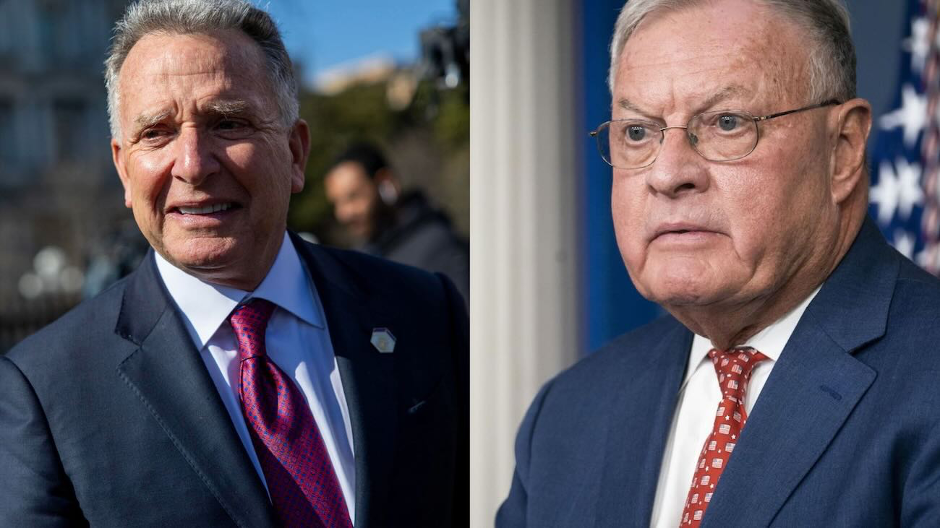
Witkoff / Kellogg – On the same team – are they pulling in the same direction?
Contradictorily, the other American envoy, General Keitz Kellogg, announces completely different solution plans. He wants to divide up Ukraine as happened with Germany after the Second World War, freeze the conflict on the line of contact, with Russia temporarily administering the eastern oblasts it now occupies and the Europeans defending the western areas of Ukraine, with an independent remainder of Ukraine in the middle. After that, Odessa and access to the Black Sea in particular would remain in the hands of the British and French (which Mark Rutte as NATO Secretary General also promised at a recent meeting with Selensky in Odessa). This plan will fail, because Putin and Lavrov never tire of emphasizing that the conflict must be resolved in such a way that the origins of the conflict (NATO’s eastward expansion) must be taken into account. NATO troops or European troops on Ukrainian territory would be in complete contradiction to this.
If Trump is really serious about peace, he must fire General Kellogg, take a clear line and end military support for Ukraine. The Russians have time and will continue as if there were no negotiations at all and adopt a low or no expectation attitude towards the Americans. That is wise.
We therefore consider this flashpoint to be relatively harmless. We virtually rule out a nuclear escalation, as was feared last year. I doubt that the Europeans could do anything that could turn Ukraine into a firestorm, even if Friedrich Merz is waving his Taurus missiles around like a berserker.
Smoldering fire 4: Iran
We are convinced that military intervention by the US in Iran would lead to disaster for the Americans. For 10 years, Yemen has been bombed by the Saudis, the Israelis, the British and now intensively by the Americans. Apart from civilian deaths, the Americans are in no way succeeding in defeating the Houthis.
Compared to Iran, the Houthis are vanishingly small. We have already reported on an American war against Iran in “Trump-Putin: A deal, Yalta or no deal?” and refer to it.
I assume that Trump is slowly realizing that such an adventure as a war against Iran would have about as much chance as Hitler’s invasion of the Soviet Union in 1941. This will probably also be the reason why Trump now wants to negotiate directly with the Iranians. In our opinion, the main issue for the Americans is a fantasy that has been nurtured by Netanyahu for 25 years: The Iranians’ nuclear bomb. The Iranians don’t have a bomb and don’t want one. The Iranians want to normalize relations with the West after being battered by the US since 1979. So this is not about a danger emanating from Iran, but about Netanyahu’s interests.
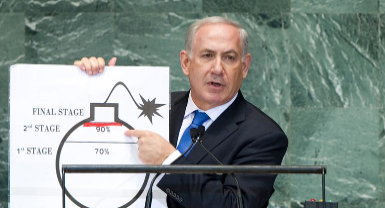
Netanyahu: Goebbels system – tell the same lie 100 times and everyone will believe it
As a full member of BRICS and the SCO, Iran is already very well integrated with the major powers Russia and China.
Despite the clamor for war coming from Jerusalem and Washington, we assume – possibly to the great astonishment of many readers – that we do not consider this smoldering fire to be really critical. This is also because there is a direct connection with smoldering fire 1: The fragile Western financial system, whose basis is the exorbitant national debt of the US, needs global economic stabilization to survive. If, for example, the price of oil were to rise to 200 dollars per barrel in the course of a war in the Middle East, this would also mean the collapse of the Western financial system as a whole.
Smoldering fire 5: Europe
Europeans still behave as if they were the world leaders they once were. The self-perception of these people is grotesque. Economically, Europe is on the decline. This can be demonstrated by one figure: in 1980, Europe’s GDP was ten times greater than that of China; in 2024 they will be on a par, and in 15 years China’s economic output will be twice that of Europe.
There are many reasons for this: misguided education policies, a lack of cheap energy from Russia, insane green policies, wrong decisions by large companies, a lack of competence among political leaders and many of the 750 million inhabitants themselves contribute to this result: They are spoiled, woke, indolent, self-absorbed and lazy. In contrast, there are 1.4 billion Chinese who work at least twice as hard.
But that doesn’t stop Europeans from opposing Russia, China and, more recently, the US, against the will of the people concerned. The powerful in the countries concerned break the law by politically neutralizing leading politicians or parties through court rulings (Le Pen) or threatening them by excluding parties that they do not approve of from forming a government, contrary to the will of the people (AFD). Ms. von der Leyen, the unelected “leader” of the EU – yes, it is a family tradition – does not shy away from having election results in other countries that she does not approve of (Romania) annulled by the judges there. Many countries in Europe find themselves in a legal vacuum and are going under economically.
The US, Russia and China don’t have to worry about these dwarf uprisings. It is the people who live there who need to worry. We consider the risk of internal unrest in Europe to be considerable, especially if the great dissatisfaction already prevailing in the populations concerned is fueled by an economic collapse.
Conclusion
The five smoldering fires described are of varying degrees of danger. The greatest danger comes from smouldering fire 1: For decades, augurs have known that the Ponzi scheme of American national debt is doomed. Over the years, the principle of hope has always applied: confidence in America’s strength as a military and financial power has been unshakeable. Despite the obvious erosion of purchasing power, the US dollar was the last safe haven. Now, however, the symptoms of decline are piling up and, above all, alternatives are emerging. Russia and China are showing how cooperation is possible. BRICS acts like a beacon and a magnet.
The Trump administration is desperately fighting the downfall of the Western system. The fact that it also has to deal with internal infighting does not make things any easier. Added to this is the unspeakable ignorance and hubris of its representatives.
We can only hope that, in the end, there is enough residual reason to recognize that the aforementioned smoldering fires were started by themselves and that they would therefore be able to suppress them instead of causing an apocalypse.
That would be entirely possible. But the opposite is also possible – unfortunately.
https://www.unz.com/article/everything-is-possible-unfortunately
